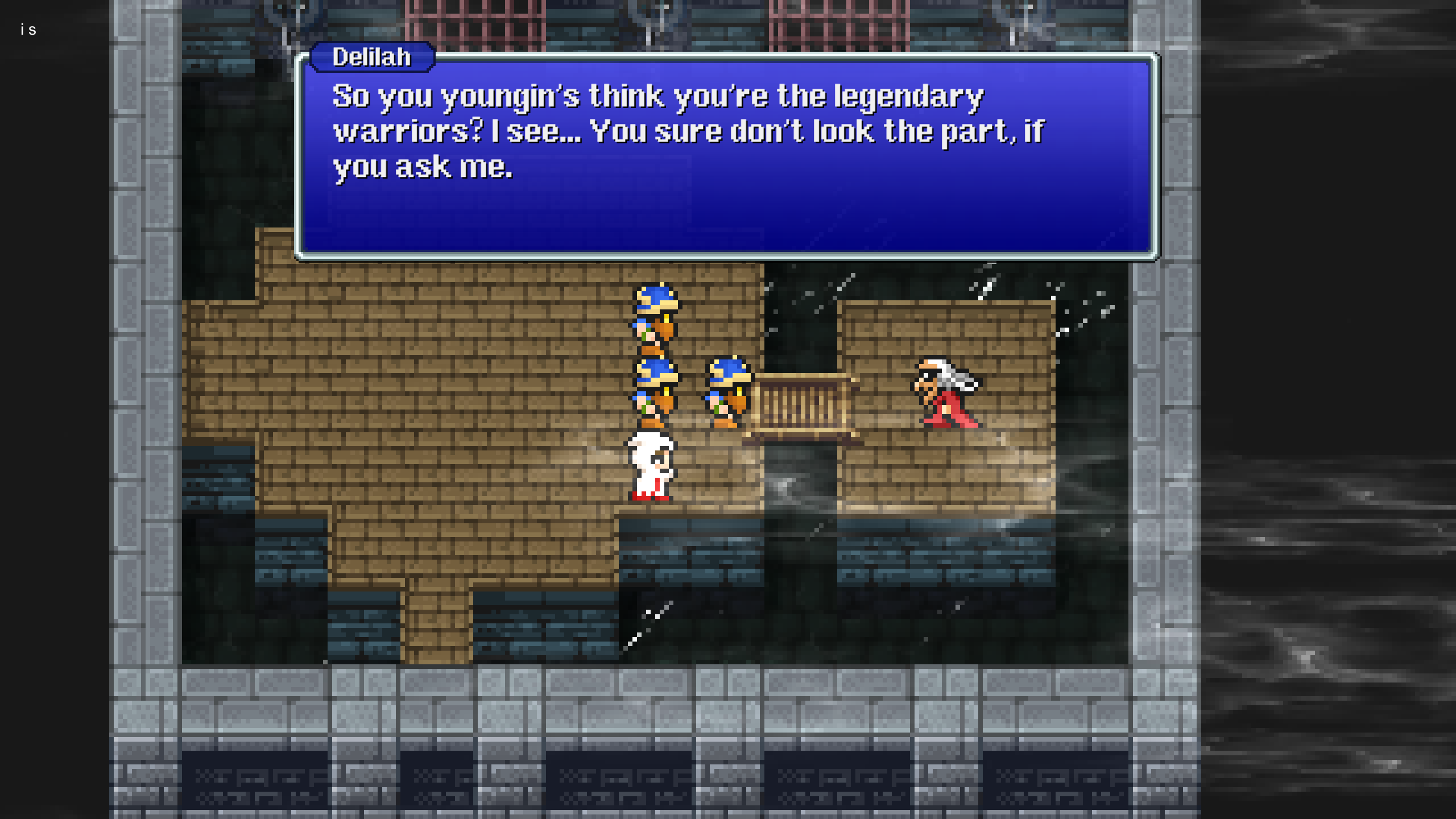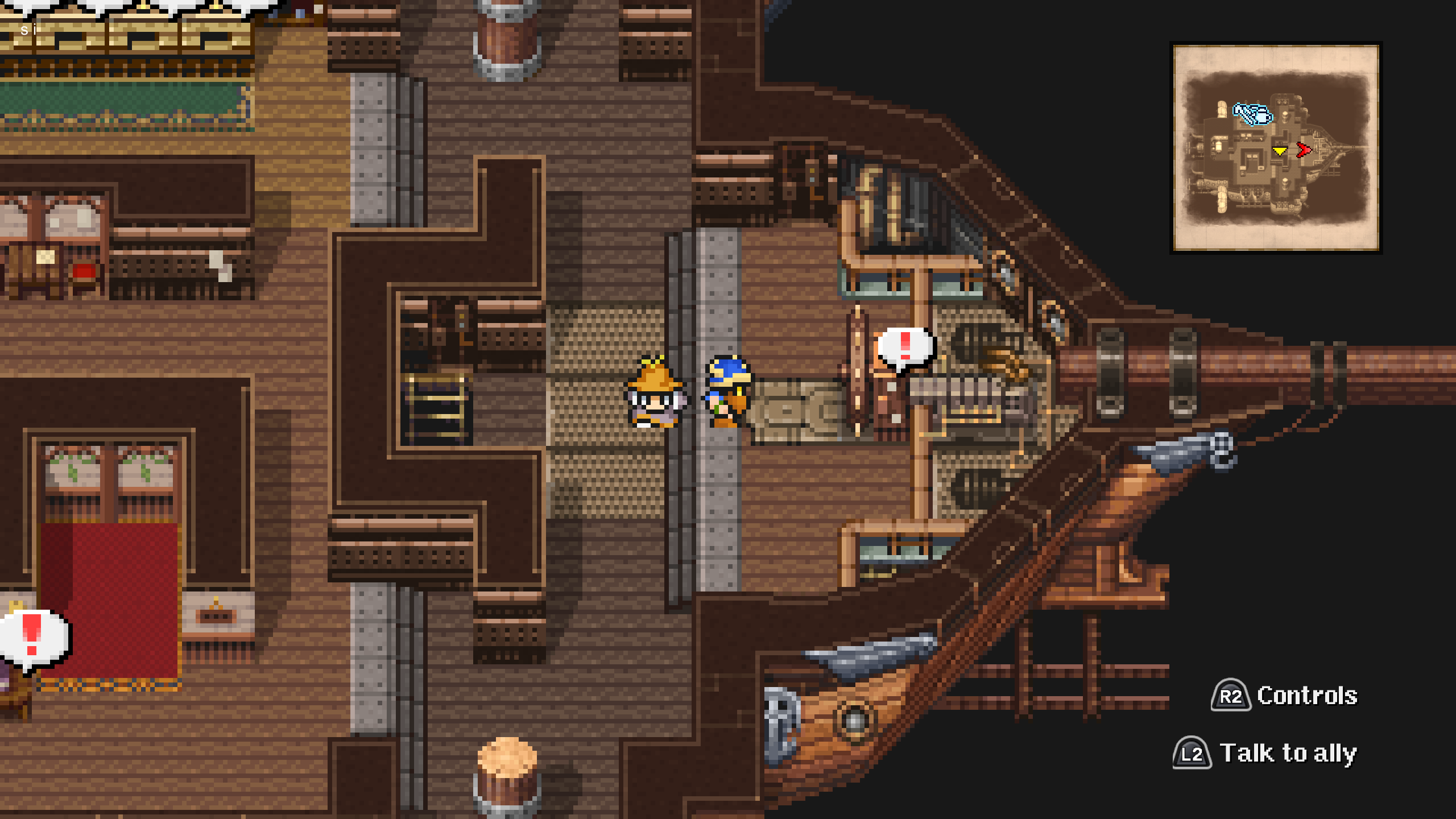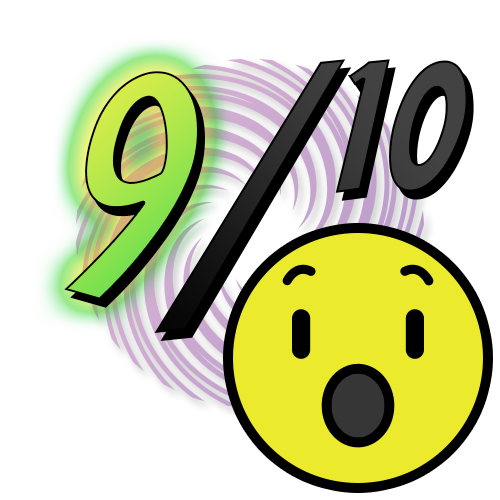| Title | Platform/Version | Time to Beat | Achiev % |
|---|---|---|---|
| Final Fantasy III | PC (Pixel Remaster) | 12 Hours | 100% |
| Used Modifications: – Pixel Text Replacement – Playstation Button Replacement – 2x Speed modification (to assist in mindless grinding) |
Intro – Cutting Onions
Final Fantasy III was originally released in 1990 in Japan, and was the last game in the series developed for the Nintendo Entertainment System as one of the largest and most complex games published on the platform, requiring a 512KB cartridge. The game was planned to be localized for US audiences, but due to the release of the Super Nintendo and the excitement about the move to 16-bit, plans were scrapped and the US would not see a version of this game until 2006’s Nintendo DS remake.
After the mixed reception to FFII’s dramatic system changes, FFIII saw Square going back to the formula used in FFI, with a return to the whimsical storytelling and generic main characters. But where FFII took enormous risks in gameplay, FFIII instead leaned into a strategy of just delivering more and more of what feels right. Essentially, FFIII is the true successor to FFI, simply taking everything that worked in the original and amplifying it to a satisfying extreme.
Whimsical vs Cinematic
I wanted to take a moment to do a small dive into a concept that I’ve been formulating, a cancept that will be important going forward as I continue to revisit these games. This idea came to me as an epiphany after having played FFII for the first time, and then immediately following it with FFIII, and it’s that there are effectively two theme “templates” that games in the Final Fantasy series fall into: Whimsical and Cinematic. I’m not the first person to make this connection, but in my research into the subject, most others refer to this difference as “early FFs” vs “later FFs”, or “Lighthearted FFs” vs “Gritty FFs” or something similar. Usually, they are referring to 1-6 as a “bucket” and then all the games from 7 onward in the other “bucket”. While there is a definite stylistic presentation change between the 2d games and the 3d games (as one would expect), I do not agree with the above separation criteria. Let me explain.
To me, a Whimsical Final Fantasy game is one where the plot and story is often just taken at face value. It is a game that follows established tropes to the letter in a nearly fourth-wall breaking way. These games trust the audience to not challenge the lack of consistency in the world building or narrative. These games are often lighthearted, fanciful, and include immersion breaking elements and sequences that are present solely to put a smile on your face or pay direct homage to something (often a previous game in the series). They are presented with vibrant color palettes and the music is often “mystical”, with a strong traditional fantasy feel.
The Collins Dictionary defines something whimsical as being “unusual, playful, and unpredictable, rather than serious and practical.”
I think this particular definition is appropriate for my categorization.
In contrast, Cinematic Final Fantasy games put much more emphasis on the story and the consistency in tone and theme. Games in the Cinematic category are often, but not always, presented with darker color palettes, and include music themes that are more varied and nuanced to assist in telling the story.
To be clear, both categories include all of the Final Fantasy staples, with each game often reimagining series staples with references to crystals, mythical creatures, and often reusing weapon/spell names in a way that each game feels like returning “home”, even if the actual presentation of each of these elements is widely different from game to game.
But using the above definitions, I’ve been able to break down the games into buckets that, when you look at them through this particular lens, makes the strengths/weaknesses of each game more palatable while also helping to understand why such wildly different decisions were made with each. I’ll go into more detail with each game from here on out, but for now, here’s my work-in-progress breakdown of the series into these categories:
| Whimsical | Cinematic |
|---|---|
| Final Fantasy I | Final Fantasy II |
| Final Fantasy III | Final Fantasy V* |
| Final Fantasy IV | Final Fantasy VI |
| Final Fantasy V* | Final Fantasy VII |
| Final Fantasy IX | Final Fantasy VIII |
| Final Fantasy Crystal Chronicles | Final Fantasy X |
| Final Fantasy Tactics Advance | Final Fantasy XII |
| Final Fantasy Tactics A2 | Final Fantasy XIII |
| Final Fantasy: The 4 Heroes of Light | Final Fantasy XV |
| Final Fantasy Tactics |
Framing things this way helps me understand why I enjoyed FFII‘s story so much, and it helps me stomach how disappointing the “step back” in storytelling in FFIII is, because it’s really just a different style choice. It also… kind of makes me look much more fondly on FFII and its bold and risky decision to tell such a mature story when no other game on the NES was anywhere close.
Anyways, I digress. Back to the FFIII review!
The Story
Final Fantasy III begins with an introduction to our 4 nameless heroes, all orphans who look identical outside of a palette swap, who are playing in a cave near their hometown when they stumble on a crystal and are told they need to save the world from darkness.
Yes, really. It’s that simple. And basic. And… ugh.
So, from the outset, I was disappointed with the story setup for this game. For me, personally, character-driven storytelling is the most potent way to make me invested and connected with the story. And this game choses to go back to Final Fantasy I’s style of four nameless heroes who just stumble their way through saving the world. This is my first time playing this version of FFIII, as my only previous playthrough was on the 2006 DS Remake which remedies this opening by giving the characters names and personalities, but the Pixel Remaster used the 1990 NES original as the basis for the story, so this is what I was stuck with.
That being said, there are a couple of key differences between this and the barren FF1 story.
- The characters DO talk in this game. Luneth (or whatever you name the “first character”) is often considered the leader and voice of the party, but there are a few instances where it’s assumed that all four party members are talking.
- The story that happens around these characters, the NPC’s, and the general epic journey they go on, is much more robust.
After touching the cave crystal and being given our quest, the four heroes set out to find the remaining crystals. Along the way, the party encounters five key NPC characters that join the party as guests and accompany them on legs of the quest, along with a few more NPC’s that help flesh out the rest of the story. While we always feel like passive audience members in the tales of these NPC’s, the level of thematic depth given to the worldbuilding for these other NPCs is what drives the story.
In the first two acts of the game, our heroes explore every nook and cranny of the known world before coming to realize that their whole lives, the world they thought they knew was instead simply a floating continent above yet another entire world below. After meeting Princess Sara, Cid the Airship Designer (and obtaining not one, but TWO airships from him), and Desch the reawakened ancient protector of the continent, we eventually take off from our home and explore the world below.
Act three has us exploring the world below, finding the remaining crystals, and meeting Doga and Unei, two immortal beings that feed us the remaining exposition to drive us to the games climax.
While the game starts off slow, the themes presented here are actually thought-provoking and became a huge inspiration later on for the Final Fantasy XIV team when developing their story. Primarily, Final Fantasy III sets up the concept of “Light” and “Dark” both being necessary forces. We aren’t fighting for the side of Light simply because “light good, dark bad”, but instead because right now, the side of Dark is becoming overpoweringly powerful. However, hundreds of years in the past, the power of Light had become too powerful and almost destroyed the world before four “Heroes of Darkness” stopped the light.
This idea that this eternal battle is cyclical and unending, painting both sides and the respective characters as shades of grey instead of simply “good and evil” is a core theme in later Final Fantasy games. The idea that there are equally heroic “Warriors of Darkness” to counter the traditional “Warriors of Light” is just awesome and this games climax which involves our party actually working WITH the Warriors of Darkness to bring balance back to the world is just perfection.
The Gameplay
FFIII returns back to the class-based system from FFI, with a traditional level-up system. However, unlike FFI which lacked pretty much any semblance of player agency outside of the initial character class choice, FFIII instead introduces quite possibly the most important gameplay system the series would ever see: The Job system.
At its core, this is just the ability for your character to have two levels of growth: Character Level, and Job level. The character level dictates the general strength of the character, while the job level is specific to each job and determines the efficacy of job-related abilities. Each character can swap between jobs however often the player wishes.
This system was incredibly influential not only on future games in the series (in particular FFV, FFXII, and the Tactics mini-series), but also on JRPGs in general. The idea that the role of each character can be fluid and changed to fit the preferences of the player or the needs of the story was revolutionary for the time and became a staple throughout the genre moving forward.
As the player reaches the four crystals, they unlock more and more diverse and powerful job classes to switch to. From the outset, the first crystal unlocks the core classes from FF1 sans the thief: Fighter, Monk, White Mage, Black Mage, and Red Mage. But by the end of the game, there are nearly two dozen jobs to choose from, each playing different from the rest. Even the Devout/Magus classes, which act as almost strict upgrades to White Mage/Black Mage respectively, are unique in that their spread of spell slots is different (far less low-level slots, but slightly more high-level slots, making them a stronger choice vs bosses but much weaker during long dungeon crawls).
This choice doesn’t just impact player agency and character personalization, but the system is also a method for informing the story. There are aspects of the story where the characters shrink themselves using the “mini” spell and must complete entire dungeons in this state. When miniaturized, all regular attacks are reduced to 1 damage. In a game like FF1, where it’s entirely possible to have no magic damage in your party, this would become a hard roadblock in the story. But with FFIII’s Job System, you simply change your whole party into caster jobs so that every character can heal or do magic damage to get through.
There’s another instance later in the game where a particular boss is strong to any type of attack other than that of the Dragoon’s “Jump” skill. Once again, the party can simply become dragoons, equip spears, jump around all they like, and then after the fight, switch back to whatever job they were previous to the fight without impacting their characters growth.
It’s just great. Outside of that, the game plays just like FFI. Gone are FFII’s passwords and keywords (thank god), and the only meaningful addition is the ability to “bank” and withdraw items using the series’ first appearance of the iconic FAT CHOCOBO. That being said, I… don’t know why you’d ever need to bank or withdraw items from this version of the game, as the inventory size is never an issue.
The Music Highlights
I just wanted to share some highlights. As I mentioned before, FFXIV makes several direct references to this game, and has a whole arc of its story that is implied to be a part of/continuation of this story. As homage, FFXIV includes remasters/remixes of several themes and listening to them both in the original game, and in the remastered versions in FFXIV, it blows my mind that these songs were in an NES game from 1990.
Eternal Wind (World Map Theme)
Let Me Know the Truth (Doga and Unei’s theme)
The Crystal Tower (Theme)
Extras & Achievements
By far the easiest game to get the achievements for thus far. The hardest achievement here was “Item Detector” which is finding all the hidden items in the game (Items that are not in chests but instead are just invisible until you walk up to them and your character gets an “!” over its head) but I found them all relatively easily as the game gives you a total of these per location.
There were three “optional bosses” (Green Dragon, Yellow Dragon, and Red Dragon”) that are found on floors 5, 6, and 7 respectively of the Crystal Tower endgame dungeon, similar to WarMech and Iron Giant these fights occur as very rare random encounters. That being said, these dragons were not hard to encounter or to defeat and felt just like normal enemies, albeit with a rarer encounter rate.
TECHNICALLY, the Ancient Library/Eureka is “optional” content, which has several bosses (including Amon), several ultimate weapons (Excalibur, Ragnarok), and unlocks the final two jobs (Sage and Ninja), but I don’t imagine anyone playing the game would skip this dungeon. It’s not hidden at all, and is just a part of the Crystal Tower.

Final Fantasy Staples Introduced
(Please note that this is not supposed to be an exhaustive list, just those things that I personally noticed and took note of during my playthrough)
- First appearance of the Jobs:
- Onion Knight (Freelancer/Squire in other games of the series)
- Ranger/Archer
- Scholar
- Geomancer
- Viking
- Dark Knight (!!! although it plays closer to what the series would later call the Samurai Job)
- Evoker/Summoner (!!!!!!!!!!!)
- Bard (!!!)
- Sage
- Ninja (!!!)
- Magus (Although it’s basically a Black Wizard from FF1 and isn’t commonly included in later titles)
- Devout (Although it’s basically a White Wizard from FF1 and isn’t commonly included in later titles)
- First time that the player can change jobs mid-game. (Referred to as the “Job System”)
- First time that the player can use the “Steal” command in combat. (Comes with thief job)
- First time Back-Attacks are introduced (Variation on “ambush” where your character’s rows are swapped and you fight from the left side of the screen instead of the right)
- First time the game featured more than one airship (FOUR in this game. FOUR.)
- First time the party can freely explore underwater
- First time appearance of the Fat Chocobo! <3 <3 <3 <3
- First time appearance of MOOGLES. <3 <3 <3 <3 <3 K U P O !
- First time the story has had multiple “worlds” (or at least, levels of world map)
- First appearance of staple magic:
- Curaja (“Cure 4”)
- Chocobo (Summon)
- Shiva (Summon)
- Ifrit (Summon)
- Titan (Summon)
- Leviathan (Summon)
- Odin (Summon)
- Bahamut (Summon)
- First appearance of staple monsters:
- First appearance of staple items:
- Ragnarok (Legendary Sword, often the most powerful weapon in existence)
- Masamune (Legendary Sword. Funnily, the in-game tooltip claims that it’s the strongest sword… but Ragnarok exists in this game and is… much stronger)
- Genji Equipment (Oftentimes the strongest armor/accessories in the game)
Final Thoughts & Score
This game is just an even better Final Fantasy I. Is the story simple? Yes. Are the characters devoid of any sort of discernible personality? Yes. But the themes and concepts introduced in this game are still great and I was invested throughout. Additionally, the job system is a potent, addictive drug that has you trying out many different combinations throughout the game, and it was always satisfying to see your choices actually meaningfully change how the characters played.
The strength of the fourth act, with the Crystal Tower (such an iconic last dungeon), the culmination of the light/dark themes, on top of a truly formidable last boss in The Cloud of Darkness, this game was a delight to play through. Now on to Final Fantasy IV and a return to more meaty character-based storytelling!
























































Leave a Reply